HITLER JUBILANT AFTER MUSSOLINI’S RESCUE
Fuehrer HQ, Rastenburg, Germany • September 12, 1943
On September 11, 1943, imprisoned in the Hotel Campo Imperatore high in the Apennine Mountains, deposed Italian dictator Benito Mussolini learned of the terms of the Long Armistice the Allies had presented to Marshal Pietro Badoglio’s new Italian government. (A Short Armistice had been signed in Sicily on September 3 between Italy and the Allies, who believed an armistice was needed to facilitate Operation Avalanche, their landings on the Italian mainland on September 8 and 9.) The Long Armistice had been pushed by Britain to humiliate Italy for having declared war on the British Empire. It required the Italians to turn over Mussolini and other high-ranking Fascists suspected of having committed war crimes against the forces of the “United Nations.”
Il Duce (Italian, “the leader”) considered suicide while his friend and Axis partner Adolf Hitler pressed his special rescue operations team ever more urgently to discover where Badoglio’s government had hidden Mussolini and snatch him to safety. It was a cat-and-mouse game as the Badoglio government moved Mussolini from police barracks in Rome, to an island in the Tyrrhenian Sea, to the island of La Maddalena near Sardinia, to finally the mainland in the area of the Gran Sasso d’Italia (“Great Stone of Italy”) mountain, a popular skiing center with a hotel, the Campo Imperatore, that could only be reached by cable-car—clearly a place hard to get to and easy to defend.
But Mussolini’s German rescuers were clever, resourceful, and capable of following Mussolini’s movements within hours or days in a country where few secrets were kept. On this date, September 12, 1943, a few planes, 8 towed gliders, and 90 crack Luftwaffe airborne troops (Fallshirmjaeger) landed without resistance on the back slope of the hotel. Accompanying the airborne troops was a burly, scar-faced, 35‑year-old Waffen‑SS captain by the name of Otto Skorzeny and 15 of his SS commandos. Neither Mussolini’s abductors nor his surprised captors (200 well-equipped military police) exchanged a shot. After a few snapshots of Skorzeny and Mussolini before the hotel, Skorzeny squeezed himself and the liberated dictator into a single-engine, 2‑seater plane and made off with his prize. Operation Eiche (Oak), or the Gran Sasso Raid, was a propaganda coup for the Nazis, who flew Mussolini to Hitler’s East Prussian headquarters, then back to Northern Italy. There Il Duce was installed as puppet ruler of a second (and last) incarnation of a Fascist Italian State, the Repubblica Sociale Italiana, informally known as the Salò Republic.
Operation Oak: High-Stakes Rescue of Imprisoned Italian Dictator Benito Mussolini, September 12, 1943
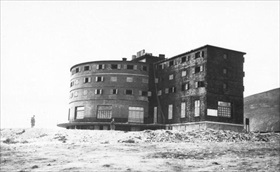 | 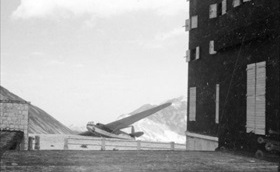 |
Left: The isolated alpine ski resort Campo Imperatore Hotel in 1943, where deposed dictator Benito Mussolini was eventually incarcerated. Mussolini’s Axis partner, Adolf Hitler, claimed that he would not let “Italy’s greatest son” down in his hour of need. His “old ally and dear friend” had to be rescued. The rescue was the last of Hitler’s spectacular gambles to bear fruit.
![]()
Right: Ninety paratroopers under the command of Major Harald-Otto Mors along with 15 select commandos led by Waffen-SS captain Otto Skorzeny crash-landed gliders onto the hotel’s boulder-strewn slopes, then overwhelmed Mussolini’s stunned jailers without firing a single shot. Skorzeny rushed passed the paratroopers to greet Mussolini, boasting, “Duce, the Fuehrer has sent me to set you free!” To which Mussolini replied, “I knew that my friend would not forsake me!”
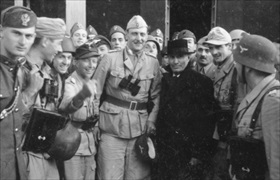 | 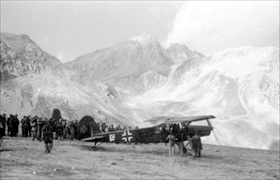 |
Left: Otto Skorzeny (center, dangling binoculars) with the liberated Mussolini and to Skorzeny’s right the slightly build Harald-Otto Mors, planner and leader of the Luftwaffe operation, Hotel Campo Imperatore, September 12, 1943. Photograph by Toni Schneiders who was attached to Mors’ paratroop battalion. The high-risk rescue saved Mussolini from being turned over to the Allies under the terms of the Long Armistice and catapulted the self-promoting SS commando leader to worldwide fame. Skorzeny received a promotion to Sturmbannfuehrer, a Nazi Party paramilitary rank equivalent to major, and was awarded the Knight’s Cross of the Iron Cross.
![]()
Right: From his work on the intelligence side of the Luftwaffe raid, Skorzeny knew that only a light plane with short takeoff and landing capabilities stood a chance of getting Mussolini off the mountain, so it was decided to land a 2‑person, highly maneuverable Fieseler Storch (“Stork”) spotter plane on the uneven plateau. It was a hair-raising takeoff as the pilot, Skorzeny (who had forced his way into the aircraft), and Mussolini (Skorzeny’s future meal ticket) in the now overloaded Storch toppled over the edge of the mountain into the abyss below. A hundred feet/30 m from their doom on the valley floor, the men were saved when the pilot was able to correct the aircraft. Mussolini transferred to a Heinkel 111 twin-engine and was eventually flown to the Hitler’s Rastenburg headquarters in East Prussia via Vienna and Munich.
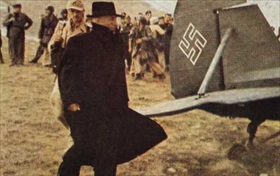 | 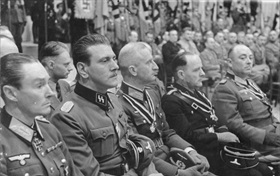 |
Left: Mussolini departed the Campo Imperatore Hotel for the Storch wearing a heavy coat and heavy ski boots. His rescue was one of the most famous commando operations of war, and it shocked the Allies. Eleven days after his rescue, Mussolini returned to German-occupied Italy, where he was installed as the titular head of the puppet Salò Republic.
![]()
Right: The Luftwaffe’s successful exploit produced a rare late-war public relations blip to sagging Axis fortunes thanks to German propaganda organs, for it keep at least the appearance that Italy was still in the war on the Axis side. On October 3, 1943, Nazi Germany’s Thanksgiving Day, Berliners gathered in the Sport Palace to cheer Skorzeny (second from left in photo) and some of the brave glider-borne raiders who had extracted the deposed dictator from the hands of his enemies.
Operation Oak: The Raid to Free Imprisoned Benito Mussolini, September 12, 1943
![]()

 History buffs, there is good news! The Daily Chronicles of World War II is now available as an ebook for $4.99 on Amazon.com. Containing a year’s worth of dated entries from this website, the ebook brings the story of this tumultuous era to life in a compelling, authoritative, and succinct manner. Featuring inventive navigation aids, the ebook enables readers to instantly move forward or backward by month and date to different dated entries. Simple and elegant! Click
History buffs, there is good news! The Daily Chronicles of World War II is now available as an ebook for $4.99 on Amazon.com. Containing a year’s worth of dated entries from this website, the ebook brings the story of this tumultuous era to life in a compelling, authoritative, and succinct manner. Featuring inventive navigation aids, the ebook enables readers to instantly move forward or backward by month and date to different dated entries. Simple and elegant! Click 











